Boseong
|
Boseong 보성군 |
||
|---|---|---|
| County | ||
| Korean transcription(s) | ||
| • Hangul | ||
| • Hanja | ||
| • Revised Romanization | Boseong-gun | |
| • McCune-Reischauer | Posŏng-gun | |

Green tea field in Boseong
|
||
|
||
 Location in South Korea |
||
| Country |
|
|
| Region | Honam | |
| Administrative divisions | 2 eup, 10 myeon | |
| Area | ||
| • Total | 663.16 km2 (256.05 sq mi) | |
| Population (2001) | ||
| • Total | 61,329 | |
| • Density | 92/km2 (240/sq mi) | |
| • Dialect | Jeolla | |
Boseong County (Boseong-gun) is a county in South Jeolla Province, South Korea. Boseong is famous for its green tea leaves. It is also the birthplace of the Korean independence activist Philip Jaisohn.
In the Samhan era, Boseong belonged to the Mahan confederacy and later became Bokhol County (伏忽郡) under the rule of the Baekje dynasty. The name "Boseong" was given in Unified Silla. One of the townships, Beolgyo (벌교), was one of the primary locations where the Japanese deprived Korean people of rice.
Large areas consist of mountains such as Mangil-Bong, Jonje Mountain and Joowol Mountain. The Boseong River flows through the center of Boseong. The multipurpose Juam Dam was built on the Boseong River in 1990.
Boseong is one of the rainiest place in South Korea.It has a moderate climate.The average annual temperature is 12.6℃. The average temperature in January is -0.5℃ and the average temperature in August is 27.8℃. Annual mean precipitation is 1,450㎜.
Boseong consist of two towns-Boseong town and Beolgyo town. Every town of population is gradually decreased.
Boseong Green Tea is a special product produced in Bodsung district and well known for great quality.
Boseong is known as the green tea capital of Korea. The surrounding climate and soil provide good conditions for growing a unique green tea that has a distinct taste and aroma. Almost one third of all tea farmland is located in Boseong and nearly half of all green tea production in Korea comes from the area. This status has been carefully crafted in recent decades, partly due to the long history green tea has with the area.
Green tea has been produced in Boseong for the past 1600 years. The earliest historical mention of green tea in Korea was from the reign of Queen Seondeok of Silla in the mid-7th century AD. Nearly two hundred years later, historical records indicate green tea seeds were planted at the foot of nearby Jirisan Mountain. During the Joseon dynasty, green tea began to fall out of favor due to its close association with Buddhism, but was still enjoyed by certain parts of the population and the Jirisan plantation continued to thrive. But it was not until the 1930s that green tea was produced on a large-scale basis. By the 1970s, huge, terraced farms as large as 250 acres became commonplace among local mountainsides. The 1980s marked the beginning of a decline in green tea demand which resulted in lower green tea output and a degradation of crops. It was then that the local government decided to reinvigorate the green tea industry by subsidizing local green tea businesses and developing newer, more efficient means to increase output and quality by collaborating with local universities and research institutes. Local media outlets also made efforts to paint Boseong as the green tea capital of the country to increase dominance in the industry by local businesses and draw in tourists from around the country.
...
Wikipedia

